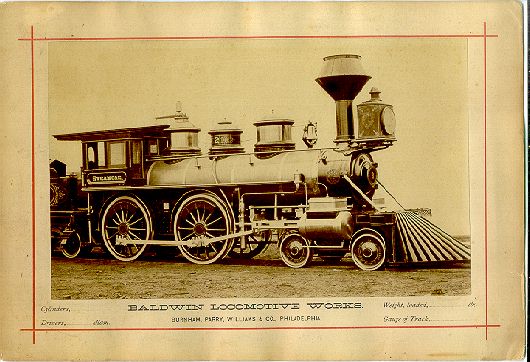On February 4, 1875, our namesake, Jack McMurdo, went for a little ride on a train and then on into history.
The Canon tells us almost nothing about the train itself, except that it had at least two passenger cars.
It is most likely that given its setting, it was also pulling empty ore and coal cars back to be reloaded at the mines. We know that actual smelting of iron ore was taking place on the hillsides, given the mention of slag heaps, cinder dumps, and the red glow of furnaces, which must have been blast furnaces used in the production of pig iron. Slag and cinders are not the byproducts of mining coal and iron, but of ore reduction, although we cannot be certain of Doyle’s knowledge of these processes. Mention of the shafts of collieries definitely tells us there were coal mines. The reference to the iron and coal valleys of the Vermissa district indicates iron mines as well, and of course there would be no need to have furnaces to simply burn up the coal that was being mined. In any event the railroad had to be used to transport coal and iron from whatever source to the furnaces, and then to transport the refined iron to its users.
The railroad line was called the State & Merton County Railroad Company (S&MC RR). Small railroads serving a special regional function were referred to as “short lines”, which accurately describes the operation of the S&MC.
The locomotive in service at the time was most likely a Baldwin, the predominant maker of locomotives of the era. The Baldwin Locomotive Works was headquartered in the Philadelphia area which is in Pennsylvania, the location of the Vermissa Valley.
Here are two photos of Baldwin Locomotives of the era. The locomotives of the S&MC were probably fairly new, given the prosperity of the mining district, and that fact that there would have been plenty of investment money for expansion and modernization during and following the Civil War.

Baldwin Works Builder Photo for S&MC
The photo shown is the original “Builders Photograph” of a locomotive delivered to the S&MC in 1873.
Below you see the museum locomotive “Tahoe” from the Virginia and Truckee railroad, which represents a good parallel. The “Virginia” of “Virginia and Truckee” is not the State of Virginia, it is Virginia City, Nevada, a mining town in the mountains of the West, much like Vermissa in the East. This is a credible demonstration that it is the sort of locomotive likely to have been in service on the S&MC railroad. The V&T connected to the transcontinental Union Pacific RR at Truckee, California, near the Nevada border.

Baldwin Locomotive, Virginia & Truckee
Little is known today about the State and Merton County Railroad. It did not last long as an independent operation, and soon merged with two other short lines, their names being long forgotten by history. Later, these combined lines were bought out by the Delaware, Lackawanna & Western which subsequently merged with the Nickel Plate Road, which then floundered following the consolidation of the New York Central and the Pennsylvania Railroads into the Penn Central giant.
By this time, the development of the Mesabi Iron Range in northern Minnesota and the expansion of the Soo Locks at Sault Ste. Marie, Michigan, had spelled the death of smaller iron-mining operations in the East. The mines in the Vermissa iron and coal districts had either become depleted or were not financially viable, and ceased operations.
One-hundred and thirty-six years after McMurdo’s ride up the valley, very little remains, except for crumbling remains of the masonry of the blast furnaces, and two small museums devoted to the mining boom of 1855-1890. Rain, time, freezing and thawing, dust and dirt have allowed nature to take control over the cinder dumps and slag heaps, and for the most part they are not discernible under the plant overgrowth to the casual observer.
i like the description given
Comment by taleya — December 5, 2010 @ 5:17 am